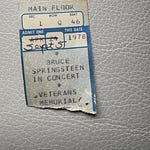Hello, friends. Thanks for being here.
On a note of personal news, I am teaching myself how to cope with the vicissitudes of life, of which there are many. “Coping” may seem like a low bar, but every mighty oak started out as an acorn.
I’m finding that simple pleasures are the key to my happiness. I’m writing—though most of it stays in the “draft” folder. I’m also knitting and crocheting, working out with my trainer twice a week, and binge listening to the Thursday Murder Club series.
I resisted Thursday Murder Club for five years because I have an oppositional streak—I tend to be skeptical of runaway bestsellers because my taste doesn’t tend to run in the same direction. While I love a cozy mystery, there’s a fine line between cozy and fluffy, and I worried Thursday might cross it. Finally, I gave in—and they’ve been an absolute joy, with intricate plots, nuanced characters, and loads of humor. Sure, there’s blood, but never excessive or gratuitous—the Brits are much better at that than the Americans.
Client News
In other news, I’ve been collaborating with Joan Lunden on her legacy memoir, which will be published in March of 2026. I’ll let you know when she settles on a title and cover design. It’s been a deeply satisfying project—not just because Joan is as delightful in person as she is on TV, but because distilling her life and accomplishments into 100,000 words was a rewarding creative challenge. Joan was the longest-running female host ever on early morning television, and her post-Good Morning America career has been equally fascinating and full.
Without giving anything away about the book, approaching her life as a story—even a novel—helped us pinpoint the defining moments that best capture her remarkable journey. Just as novels have key themes, so do life stories.
If you’re writing a memoir, thinking of yourself as the protagonist in a novel can give you the emotional distance needed to focus on the most essential moments and themes of your life’s journey.
To help shape the narrative, Joan and I studied The Wizard of Oz in five acts—then distilled her 74 years into just five paragraphs. I didn’t invent the five-act structure; there are several books and websites about both it and the three-act structure. I’m just explaining how we put it to use for Joan’s memoir.
Here’s Oz in five acts
Act 1: Setup
Dorothy lives on a farm in Kansas with her family and her dog Toto. Life is mundane, and Dorothy dreams of escaping her troubles ("Somewhere Over the Rainbow").
Catalyst for change: A tornado sweeps through Kansas. Dorothy couldn’t escape the house before it’s whisked away to the magical land of Oz.
Act 2: Introduce Conflict (Rising Action)
Dorothy's house lands on the Wicked Witch of the East, killing her. Glinda, the Good Witch, appears and gives Dorothy the ruby slippers. The Wicked Witch of the West vows revenge.
Quest Begins: Dorothy learns that to return home, she must follow the Yellow Brick Road to the Emerald City to seek help from the Wizard of Oz.
Act 3: Climax (Turning Point)
Dorothy and her friends, Scarecrow, Tin Man, and Lion face various obstacles, including the Wicked Witch of the West's attempts to stop them. They finally reach the Emerald City and meet the Wizard, who promises to grant their wishes if they bring him the Witch's broomstick.
Turning Point: The group confronts the Witch in her castle. During the struggle, Dorothy throws a bucket of water on the Witch, melting her.
Act 4: Unraveling of Events (Falling Action)
With the Witch defeated, Dorothy and her friends return to the Wizard with the broomstick. The Wizard reveals himself as an ordinary man but still helps the Scarecrow, Tin Man, and Lion realize they had what they desired all along. The hot air balloon Dorothy intended to take home to Kansas leaves without her.
Act 5: Resolution (Aftermath & Conclusion)
Glinda reappears and tells Dorothy she can return home by clicking her ruby slippers together and repeating "There's no place like home."
Dorothy wakes up in her bed in Kansas, surrounded by her family and friends. She realizes that everything she needs is right at home.
Here are the key themes in Oz.
1. The Search for Home & Belonging
Dorothy's journey is ultimately about realizing that "there's no place like home." Though she dreams of escaping Kansas, her adventures in Oz teach her to appreciate what she already has.
The theme reflects the universal longing for security, family, and a sense of belonging.
2. Self-Discovery & Inner Strength
Dorothy, the Scarecrow, Tin Man, and Lion all believe they lack something essential (home, intelligence, heart, courage), but through their journey, they prove they already possess these qualities.
The story suggests that we often seek external validation for traits we already have within us.
3. The Illusion of Power & Authority
The Wizard is revered as an all-powerful figure, but he turns out to be just an ordinary man using deception to maintain control.
This theme critiques blind faith in authority and highlights the idea that true power comes from within.
4. Good vs. Evil
The contrast between Glinda (the Good Witch) and the Wicked Witch of the West represents the battle between kindness and cruelty.
Dorothy's victory over the Witch reinforces that good can triumph over evil, often in unexpected ways.
5. Friendship & Teamwork
Dorothy doesn’t succeed alone—her friendships with the Scarecrow, Tin Man, and Lion are essential to overcoming challenges.
This highlights the importance of collaboration and mutual support.
6. The Power of Perspective & Perception
The characters initially see themselves as incomplete, only to realize they already have what they seek.
The Wizard’s illusion emphasizes how perception can shape reality, for better or worse.
Limited Offer for Memoirists
It might be easier to figure out how to use the five-act structure with the help of a friend who’s done it before. If you (or someone you know) would like to talk about your memoir project, I am offering one-hour consultations starting in April. Simply hit “reply” and tell me what you’re working on and how I might be helpful.
That’s all for me right now. Please be good to yourself and to others—all we have is each other.











